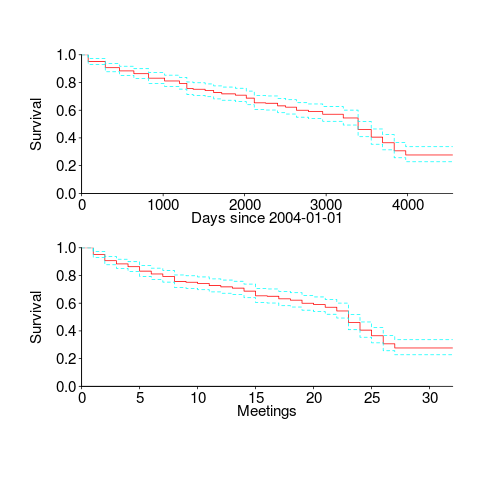Survival rate of WG21 meeting attendance
WG21, the C++ Standards committee, has a very active membership, with lots of people attending the regular meetings; there are three or four meetings a year, with an average meeting attendance of 67 (between 2004 and 2016).
The minutes of WG21 meetings list those who attend, and a while ago I downloaded these for meetings between 2004 and 2016. Last night I scraped the data and cleaned it up (or at least the attendee names).
WG21 had its first meeting in 1992, and continues to have meetings (eleven physical meetings at the time or writing). This means the data is both left and right censored; known as interval censored. Some people will have attended many meetings before the scraped data starts, and some people listed in the data may not have attended another meeting since.
What can we say about the survival rate of a person being a WG21 attendee in the future, e.g., what is the probability they will attend another meeting?
Most regular attendees are likely to miss a meeting every now and again (six people attended all 30 meetings in the dataset, with 22 attending more than 25), and I assumed that anybody who attended a meeting after 1 January 2015 was still attending. Various techniques are available to estimate the likelihood that known attendees were attending meetings prior to those in the dataset (I’m going with what ever R’s survival package does). The default behavior of R’s Surv function is to handle right censoring, the common case. Extra arguments are needed to handle interval censored data, and I think I got these right (I had to cast a logical argument to numeric for some reason; see code+data).
The survival curves in days since 1 Jan 2004, and meetings based on the first meeting in 2004, with 95% confidence bounds, look like this:

I was expecting a sharper initial reduction, and perhaps wider confidence bounds. Of the 374 people listed as attending a meeting, 177 (47%) only appear once and 36 (10%) appear twice; there is a long tail, with 1.6% appearing at every meeting. But what do I know, my experience of interval censored data is rather limited.
The half-life of attendance is 9 to 10 years, suspiciously close to the interval of the data. Perhaps a reader will scrape the minutes from earlier meetings 🙂
Within the time interval of the data, new revisions of the C++ standard occurred in 20072011 and 2014; there had also been a new release in 2003, and one was being worked on for 2017. I know some people stop attending meetings after a major milestone, such as a new standard being published. A fancier analysis would investigate the impact of standards being published on meeting attendance.
People also change jobs. Do WG21 attendees change jobs to ones that also require/allow them to attend WG21 meetings? The attendee’s company is often listed in the minutes (and is in the data). Something for intrepid readers to investigate.
Nice Analysis, Derek.
One correction – the first standard revision within your data set would have been 2011, not 2007.
And one observation – since the end of the range you used (2004-2016), WG21 attendance has skyrocketed! The last few physical meetings had numbers in the 200-300s – and was still increasing (obviously this year has scuppered all that – it will be interesting to see what happens when we resume).
I suspect that, along with that increase, would come a change in turnover, too. It would be interesting to see whether the data supports that. Maybe for your next run at this in a few years? 🙂
@Phil Nash
Thanks, fixed date.
I think that WG21 meeting will the topic of at least one anthropology PhD. POSIX meetings had even larger attendance numbers, but these was mostly preinternet, and so there is not so much raw data available.